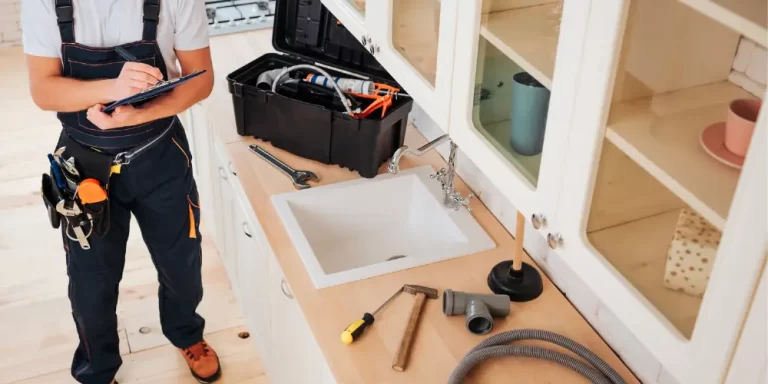How To Choose Kitchen Faucet Height?
Choosing the right kitchen faucet height may not be the first thing that comes to mind when designing or renovating a kitchen, but it plays a crucial role in both functionality and aesthetics.
This in-depth guide will explore the world of kitchen faucets and show you how to choose kitchen faucet height for your need. Your experience can be significantly impacted by the height of your faucet, whether you’re washing dishes, filling pots, or just grabbing a glass of water.
Why Faucet Height Is Important?

Faucet height refers to the vertical distance from the base of the faucet to the highest point of the spout. It determines how much clearance you have above the sink for various tasks. The height of a kitchen faucet can vary significantly, ranging from low-profile or low-arc faucets to mid-arc or medium-height faucets, and high-arc or tall faucets.
The height of a kitchen faucet is important for several reasons:
- Functionality: The right faucet height ensures optimal functionality in the kitchen. Depending on your needs, a faucet with the appropriate height can make tasks like washing dishes, filling pots, and cleaning vegetables more convenient and efficient. For example, a higher faucet allows you to easily fit large cookware under the spout without struggling or causing splashing. On the other hand, a lower faucet may be more practical for smaller sinks or if you prefer a more compact design.
- Clearance Space: Kitchen faucet height determines the amount of clearance space above the sink. This clearance is crucial for performing tasks that require extra space, such as washing tall pots or filling pitchers. If the faucet is too low, you may struggle to fit larger items under the spout or end up with water splashing outside the sink. Conversely, a faucet that is too high may result in excessive splashing or difficulty in controlling the water flow.
- Ergonomics and Ease of Use: The height of the faucet affects the ergonomics and ease of use in the kitchen. A faucet that is too low may require you to bend over or strain your back while using the sink, leading to discomfort and potential long-term health issues. Conversely, a faucet at the right height allows for a more comfortable posture and reduces strain on your body, making kitchen tasks more enjoyable and less tiring.
- Aesthetic Considerations: Kitchen faucets contribute to the overall aesthetics of the kitchen. The height of the faucet should harmonize with the style and design of your kitchen. A well-chosen faucet height can enhance the visual appeal and create a cohesive look with other fixtures and appliances. It can serve as a design element, adding elegance and sophistication to your kitchen space.
Factors to Consider When Choosing Kitchen Faucet Height

Sink and Countertop Configuration
The type of sink you have in your kitchen plays a crucial role in determining the appropriate faucet height.
For a single basin sink, you have more flexibility in choosing the faucet height since there are no dividers to consider. However, if you have a double basin sink, you need to ensure that the faucet height is suitable for both compartments and doesn’t hinder your ability to move large items between the two.
The dimensions of your sink, particularly its depth, and width, are important considerations when selecting a kitchen faucet height.
A deeper sink may require a taller faucet to ensure sufficient clearance for comfortably washing dishes and filling pots. Similarly, a wider sink might benefit from a faucet with a higher spout reach to cover a larger area.
The space between the edge of your sink and the backsplash also affects the choice of faucet height. If there is limited space between the sink and backsplash, opting for a lower faucet height can prevent splashing and ensure ease of use. However, if you have ample clearance, you can consider a higher faucet for added functionality and aesthetic appeal.
User Preferences and Needs
Your comfort and ease of use should be prioritized when choosing a kitchen faucet height. Consider your own height and the heights of other household members who frequently use the sink. The faucet should be at a height that allows for comfortable access to the water stream and easy maneuvering of hands and utensils.
If you often cook with large pots and pans, it’s important to choose a faucet height that can accommodate their size. A taller faucet with sufficient clearance between the spout and sink will make it easier to fill and clean large cookware without any restrictions.
For individuals with disabilities or limited mobility, selecting a kitchen faucet that meets accessibility standards is crucial. Opt for a faucet height that allows for easy reach and operation, considering factors such as lever handles or touchless options that minimize physical exertion.
Kitchen Style and Aesthetics
The faucet height should harmonize with the overall design style of your kitchen. For example, in a modern or contemporary kitchen, sleek and streamlined faucets with a medium to high arc can enhance the aesthetic appeal. In contrast, a traditional or farmhouse-style kitchen may benefit from a lower-profile faucet that complements the vintage charm.
Consider the height and style of other fixtures and appliances in your kitchen when choosing the faucet height.
Aim for a cohesive and balanced look by ensuring that the faucet height complements the height of your sink, cabinetry, and other nearby fixtures. If you have tall cabinets or appliances, a higher faucet height can create a visually pleasing and proportional arrangement.
Get Instant Solutions For Your Home Issues For Free - Chat With Experts
Get Paid For Your Opinion With Online Surveys - Start Earning
Different Faucet Height

Low-arc Faucets
Traditional or smaller sinks are frequently fitted with low-profile or low-arc faucets. The spout height of these faucets normally ranges from 3 to 8 inches above the sink surface. They may easily blend in with the overall aesthetic of traditional kitchens because to their modest size.
Their more understated appearance harmonizes with the overall style of these kitchens, giving them a polished appearance. A low-arc faucet also makes sure that the water stream properly reaches the center of the basin if you have a smaller sink.
Low-arc faucets offer improved functionality in small, cramped kitchens. They are easier to maneuver because of their lower profile, especially when there is little space between the faucet and the backsplash.
Mid-Arc Faucets
Mid-arc faucets are a popular choice for modern and transitional kitchens. They offer a sleek and contemporary look while maintaining a practical height that suits a wide range of sink sizes and styles. Whether you have a single basin or double basin sink, a mid-arc faucet can accommodate your needs effectively.
One of the key advantages of mid-arc faucets is their ability to strike a balance between aesthetics and practicality.
They provide sufficient clearance above the sink to accommodate various kitchen tasks while adding a touch of elegance to the space. With their medium height, these faucets offer a comfortable reach for everyday use.
High-Arc Faucets
If you have a deep or double-basin sink, a high-arc faucet is the perfect choice. The extra height allows ample space for maneuvering larger pots, pans, and dishes, making it easier to fill and clean them.
With a high-arc faucet, you can avoid any potential splashing or spilling that may occur with a lower faucet height.
Apart from their functional advantages, high-arc faucets make a striking visual statement in the kitchen.
They create a focal point and add a touch of elegance to the space. Additionally, the increased clearance provided by high-arc faucets accommodates larger cookware, such as tall stockpots or oversized baking sheets, making it convenient to use and clean such items.
How To Choose Kitchen Faucet Height?
Choosing the perfect kitchen faucet height involves considering several factors to ensure functionality, aesthetics, and ease of use. Here are some detailed steps to help you determine the right kitchen faucet height for your needs:
Measuring The Clearance Space Above The Sink
When selecting a kitchen faucet, it’s crucial to measure the clearance space between the sink and any overhead cabinets or shelves.
Measure the vertical distance from the top of the sink to the bottom of the cabinets or shelves. This measurement will give you an idea of the maximum faucet height that can be accommodated without causing any obstructions or limitations.
Considering Spout Reach and Swivel Capabilities
Apart from the height, it’s essential to consider the spout reach and swivel capabilities of the faucet. Spout reach refers to the distance from the center of the faucet’s base to the center of the water stream.
A longer spout reach may be necessary for larger sinks or if you need greater flexibility when working around the sink. Swivel capabilities allow you to rotate the faucet, providing convenience in directing the water flow where you need it.
Testing Functionality and Ease of Use
To ensure the chosen faucet height suits your needs, it’s advisable to visit a showroom or a retail store where you can physically interact with the faucets.
Try operating faucets of different heights, mimicking various kitchen tasks such as washing dishes or filling large pots. This hands-on approach allows you to assess the functionality and ease of use, ensuring that the faucet height feels comfortable and convenient for your daily kitchen activities.
Seeking Professional Advice If Unsure
If you’re still uncertain about which faucet height to choose, it’s always a good idea to seek professional advice from a plumber or a kitchen designer.
Check These - Best Selling Products on Amazon (Shop Now and Save Big)
They can provide valuable insights and recommendations based on their expertise and experience. They can consider factors such as your sink and countertop configuration, kitchen layout, and personal preferences to help you make an informed decision.
Final Words
Remember, choosing the right kitchen faucet height is important for both practicality and aesthetics. It should complement your sink, countertop, and overall kitchen design while also providing the functionality and ease of use you desire. By measuring clearance space, considering spout reach and swivel capabilities, testing functionality, and seeking professional advice when needed, you can confidently select a kitchen faucet height that meets your specific requirements.

Meet Ralph Matthews, father of 2 cute daughters and a skilled plumber with over 10 years of experience in the industry. Ralph has particular expertise in repairing any type of faucet and has helped countless homeowners and businesses solve their plumbing problems with his expert knowledge and attention to detail.






